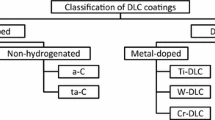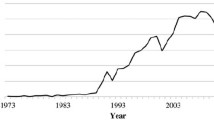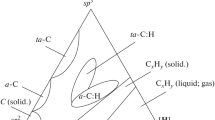Abstract
In the last ten years significant progress has been made on development and understanding of diamond-like carbon coatings (DLC), which enabled them to become one of the most promising types of protective coatings for various mechanical applications. Their main advantages are low friction, good anti-wear properties, and adhesive protection. However, due to their low surface energy their reactivity with conventional oils and additives is limited, which makes achieving effective boundary lubrication a complex task. For a qualitative step-change that would improve the performance and allow effective optimizing and tailoring of these boundary-lubricated tribological systems, it is necessary to understand the mechanisms of why, how, under which conditions, and with which materials and lubricants, the actual boundary lubrication is possible—if at all. The current results on boundary lubrication of DLC coatings are not many, and are due to the different types of coatings, lubricants and additives used in these studies, often difficult to compare and sometimes even contradictive. However, a recent great demand in different industries to apply the DLC coatings to lubricated systems requires a better understanding of these phenomena and overall performance. Therefore, if we wish to see a more effective continuation of the research and a better understanding of the scattered results, an overview of today’s state-of-the-art of lubricated DLC contacts is needed. In this paper we analyse the behaviors and suggested mechanisms from already-published studies and we summarize the present understanding of the boundary lubrication of DLC coatings. We focus on the DLC-lubricant interaction, thus we analyse only self-mated DLC/DLC contacts in order to avoid the inevitable effects from interactions with other counter materials such as steel.
Similar content being viewed by others
References
Erdemir A (2004) Diamond-like carbon films. In: Vižintin J, Kalin M, Dohda K, Jahanmir S (eds) Tribology of mechanical systems: a guide to present and future technologies. ASME, New York, pp 139–156
Grill A (1999) Diamond-like carbon: state of the art. Diam Relat Mater 8:428–434
Donnet C, Grill A (1997) Friction control of diamond-like carbon coatings. Surf Coat Technol 94–95:456–462
Matthews A, Leyland A, Holmberg K, Ronkainen H (1998) Design aspects for advanced tribological surface coatings. Surf Coat Technol 100–101:1–6
Erdemir A, Fenske GR, Terry J, Wilbur P (1997) Effect of source gas and deposition method on friction and wear performance of diamondlike carbon films. Surf Coat Technol 94–95:525–530
Fontaine J, Donnet C, Grill A, Mogne TL (2001) Tribochemistry between hydrogen and diamond-like carbon films. Surf Coat Technol 146–147:286–291
Andersson J, Erck RA, Erdemir A (2003) Friction of diamond-like carbon films in different atmospheres. Wear 254:1070–1075
Franta D, Buršíková V, Nečas D, Zajíčková L (2008) Modeling of optical constants of diamond-like carbon. Diam Relat Mater 17:705–708
Ronkainen H, Laukkanen A, Holmberg K (2007) Friction in a coated surface deformed by a sliding sphere. Wear 263:1315–1323
Pantano A, Cappello F (2008) Numerical model for composite material with polymer matrix reinforced by carbon nanotubes. Meccanica 43:263–270
Marannano G, Virzì Mariotti G (2008) Structural optimization and experimental analysis of composite material panels for naval use. Meccanica 43:251–262
Robertson J (1999) Deposition and properties of diamond-like carbon. Mater Res Soc Symp Proc 555:12
Erdemir A (2001) The role of hydrogen in tribological properties of diamond-like carbon films. Surf Coat Technol 146–147:292–297
Neuville S, Matthews A (2007) A perspective on the optimisation of hard carbon and related coatings for engineering applications. Thin Solid Films 515:6619–6653
Ronkainen H, Varjus S, Koskinenm J, Holmberg K (2001) Differentiating the tribological performance of hydrogenated and hydrogen-free DLC coatings. Wear 249:260–266
Kano M, Tanimoto I (1991) Wear mechanism of high wear-resistant materials for automotive valve trains. Wear 151:229–243
Cruz R, Rao J, Rose T, Lawson K, Nicholls JR (2006) DLC-ceramic multilayers for automotive applications. Diam Relat Mater 15:2055–2060
Franklin SE, Baranowska J (2007) Conditions affecting the sliding tribological performance of selected coatings for high vacuum bearing applications. Wear 263:1300–1305
Vanhulsel A, Velasco F, Jacobs R, Eersels L, Havermans D, Roberts EW, Sherrington I, Anderson MJ, Gaillard L (2007) DLC solid lubricant coatings on ball bearings for space applications. Tribol Int 40:1186–1194
Jiang JC, Meng WJ, Evans AG, Cooper CV (2003) Structure and mechanics of W-DLC coated spur gears. Surf Coat Technol 176:50–56
Kalin M, Vižintin J (2005) The tribological performance of DLC-coated gears lubricated with biodegradable oil in various pinion/gear material combinations. Wear 259:1270–1280
Tung SC, Gao H (2003) Tribological characteristics and surface interaction between piston ring coatings and a blend of energy-conserving oils and ethanol fuels. Wear 255:1276–1285
Etsion I, Halperin G, Becker E (2006) The effect of various surface treatments on piston pin scuffing resistance. Wear 261:785–791
Kano M (2006) Super low friction of DLC applied to engine cam follower lubricated with ester-containing oil. Tribol Int 39:1682–1685
Hershberger J, Ozturk O, Ajayi JB, Woodford JB, Erdemir A, Erck RA, Fenske GR (2004) Evaluation of DLC coatings for spark-ignited direct-injected fuel systems. Surf Coat Technol 179:237–244
Dai M, Zhou K, Yuan Z, Ding Q, Fu Z (2000) The cutting performance of diamond and DLC-coated cutting tools. Diam Relat Mater 9:1753–1757
Sato T, Besshi T, Tsutsui I, Morimoto T (2000) Anti-galling property of a diamond-like carbon coated tool in aluminium sheet forming. J Mater Process Technol 104:21–24
Sheeja D, Tay BK, Nung LN (2004) Feasibility of diamond-like carbon coatings for orthopaedic applications. Diam Relat Mater 13:184–190
Shi B, Ajayi OO, Fenske G, Erdemir A, Liang H (2003) Tribological performance of some alternative bearing materials for artificial joints. Wear 255:1015–1021
Tan AH (2007) Corrosion and tribological properties of ultra-thin DLC films with different nitrogen contents in magnetic recording media. Diam Relat Mater 16:467–472
Zhao X, Bhushan B (2000) Comparison studies on degradation mechanisms of perfluoropolyether lubricants and model lubricants. Tribol Int 9:187–197
Gatzen HH, Beck M (2003) Tribological investigations on micromachined silicon sliders. Tribol Int 36:279–283
Numata T, Nanao H, Mori S, Miyake S (2003) Chemical analysis of wear tracks on magnetic disks by TOF-SIMS. Tribol Int 36:305–309
Gahlin R, Larsson M, Hedenqvist P (2001) ME-C:H coatings in motor vehicles. Wear 249:302–309
Haque T, Morina A, Neville A, Kapadia R, Arrowsmith S (2007) Non-ferrous coating/lubricant interactions in tribological contacts: assessment of tribofilms. Tribol Int 40:1603–1612
Dahotre NB, Nayak S (2005) Nanocoatings for engine application. Surf Coat Technol 194:58–67
Erdemir A (2005) Review of engineered tribological interfaces for improved boundary lubrication. Tribol Int 38:249–256
Hsu SM, Gates RS (2005) Boundary lubricating films: formation and lubrication mechanism. Tribol Int 38:305–312
Sanchez-Lopez JC, Erdemir A, Donnet C, Rojas TC (2003) Friction-induced structural transformations of diamondlike carbon coatings under various atmospheres. Surf Coat Technol 163–164:444–450
Grischke M, Hieke A, Morgenweck F, Dimigen H (1998) Variation of the wettability of DLC-coatings by network modification using silicon and oxygen. Diam Relat Mater 7:454–458
Mortier RM, Orszulik ST (1993) Chemistry and technology of lubricants, 2nd edn. Blackie Academic Professional, Glasgow
Dorinson A, Ludema KC (1985) Mechanics and chemistry in lubrication. Tribology series, vol. 9. Elsevier, Amsterdam
Pawlak Z (2003) Tribochemistry of lubricating oils. Tribology and interface engineering series, vol. 45. Elsevier, Amsterdam
De Barros’Bouchet MI, Martin JM, Le-Mogne T, Vacher B (2005) Boundary lubrication mechanisms of carbon coatings by MoDTC and ZDDP additives. Tribol Int 38:257–264
De Barros’Bouchet MI, Le Mogne T, Martin JM, Vacher B (2006) Lubrication of carbon coatings with MoS2 single sheet formed by MoDTC and ZDDP lubricants. Lubr Sci 18:141–149
Kano M, Yasuda Y, Okamoto Y, Mabuchi Y, Hamada T, Ueno T, Ye J, Konishi S, Takeshima S, Martin JM, De Barros Bouchet MI, Le Mogne T (2005) Ultralow friction of DLC in presence of glycerol mono-oleate (GMO). Tribol Lett 18:245–251
Kalin M, Roman E, Vižintin J (2007) The effect of temperature on the tribological mechanisms and reactivity of hydrogenated, amorphous diamond-like carbon coatings under oil-lubricated conditions. Thin Solid Films 515:3644–3652
Velkavrh I, Kalin M, Vižintin J (2008) The performance and mechanisms of DLC-coated surfaces in contact with steel in boundary-lubrication conditions—a review. J Mech Eng 54(3):189–206
Kalin M, Vižintin J (2006) A comparison of the tribological behavior of steel/steel, steel/DLC and DLC/DLC contacts when lubricated with mineral and biodegradable oils. Wear 261:22–31
Barriga J, Kalin M, Van Acker K, Vercammen K, Ortega A, Leiaristi L (2006) Tribological performance of titanium doped and pure DLC coatings combined with a synthetic bio-lubricant. Wear 261:9–14
Kalin M, Vižintin J, Barriga J, Vercammen K, Van Acker K, Arnšek A (2004) The effect of doping elements and oil additives on the tribological performance of boundary-lubricated DLC/DLC contacts. Tribol Lett 17:679–688
Kalin M, Vižintin J, Vercammen K, Barriga J, Arnšek A (2006) The lubrication of DLC coatings with mineral and biodegradable oils having different polar and saturation characteristics. Surf Coat Technol 200:4515–4522
Kalin M, Vižintin J (2006) The tribological performance of DLC coatings under oil-lubricated fretting conditions. Tribol Int 39:1060–1067
Equey S, Roos S, Mueller U, Hauert R, Spencer ND, Crockett R (2007) Tribofilm formation from ZnDTP on diamond-like carbon. Wear 264(3–4):316–321
Podgornik B, Hren D, Vižintin J (2005) Low-friction behavior of boundary-lubricated diamond carbon coatings containing tungsten. Thin Solid Films 476:92–100
Podgornik B, Hren D, Vižintin J, Jacobson S, Stavlid N, Hogmark S (2006) Combination of DLC coatings and EP additives for improved tribological behavior of boundary lubricated surfaces. Wear 261:32–40
Matthews A, Rickerby DS (1991) Advanced surface coatings: a handbook of surface engineering. Blackie, Glasgow
Author information
Authors and Affiliations
Corresponding author
Rights and permissions
About this article
Cite this article
Kalin, M., Velkavrh, I., Vižintin, J. et al. Review of boundary lubrication mechanisms of DLC coatings used in mechanical applications. Meccanica 43, 623–637 (2008). https://doi.org/10.1007/s11012-008-9149-z
Received:
Accepted:
Published:
Issue Date:
DOI: https://doi.org/10.1007/s11012-008-9149-z




